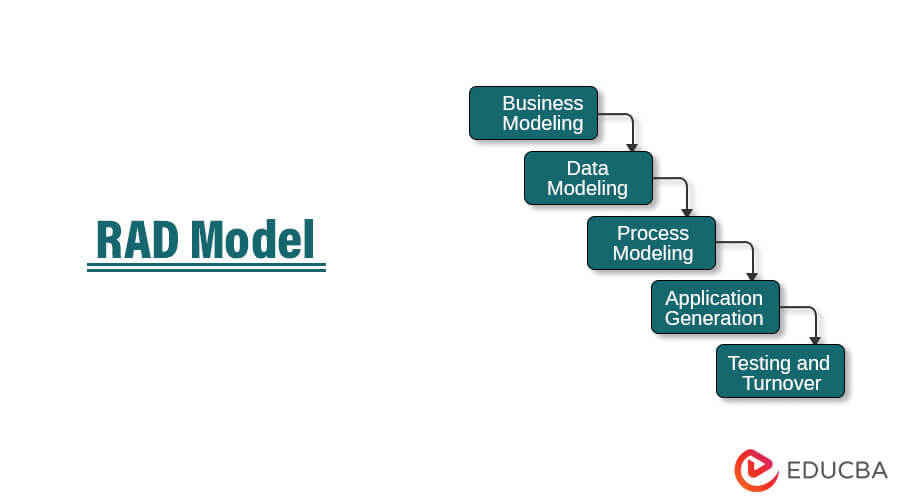Updated May 15, 2023
Introduction to RAD Model
The RAD model, which stands for Rapid Application Development model, is a software development methodology that involves parallel development of functions and subsequent integration. In this model, each component or function is developed in parallel as if it were a mini-project. The development of components is time-boxed, delivered, and then assembled into a working prototype. The model allows for rapid change and development of the components or product, and encourages active customer feedback by providing early visibility of the product to customers.
The RAD model, similar to other software development models, has its specific phases of development. They are as follows:
- Planning and Requirement Analysis
- Designing Project Architecture
- Development and Programming
- Testing
- Deployment and Maintenance
How to Pick the Best SDLC Model for the Project?
Before proceeding further, there is a crucial question that requires consideration: How to determine which Software Development Life Cycle model (SDLC) is best?
It is crucial that the selected SDLC model fulfills all the given requirements. There is no single SDLC model that meets all the requirements, and every model has its own pros and cons. Before choosing a particular model, it should be analyzed, tested properly, and then only put into practice.
What is RAD Model?
The RAD model is a popular software development model. It is a type of incremental model where multiple small chunks of development are picked and developed simultaneously to achieve the larger goal. The incremental model involves breaking down major features into smaller, more manageable chunks, which are then developed individually.
As mentioned, a typical RAD model can be divided into five phases:
1. Planning and Requirement Analysis:
This is one of the most crucial stages, where initial requirements are gathered and analyzed properly. The planning involves creating a roadmap and identifying risks and challenges. It is essential to have a proper understanding of requirements to ensure that the final product meets the expectations.
2. Designing Project Architecture:
The next task is project architecture development. The project architecture should be flexible enough to accommodate the addition of new files and folders easily. The design phase is crucial for laying the foundations for the developmental phase.
3. Development and Programming:
Now comes the task of developing the project. It involves writing piles of code so as to get the product into a feasible state. The coding process should be collaborative to ensure consistency betweem all team members.
4. Testing:
This phase involves testing of the developed product, where a designated team undertakes the task. The team reports and fixes any defects found before deployment.
5. Deployment and Maintenance:
After testing is complete, the product can now be deployed on the server. A deployed project requires maintenance such as bug fixing and regular updates to ensure smooth functioning. Furthermore, considering feedback from users is important during the addition of new features.
Advantages and Disadvantages of RAD Model
Advantages:
- Rapid development of the product
- Development of reusable small components
- Repetitive review during development
- Integration of reusable components at an early stage saves effort even without adding bigger modules
- Constructive feedback
Disadvantages:
- Requires significant effort for gathering all requirements at the initial stage
- Modeling skills have many dependencies
- Not suitable for low-budget projects
When to use the RAD Model?
The RAD model is ideal to use in the following situations:
- When there is a need to develop a product within a short timeframe
- When there is a large number of developers available, allowing for the simultaneous development of multiple components that can later be integrated into bigger modules
- Sufficient resources are available to gather all requirements at the initial stage
Why use the Spiral Model?
For a holistic understanding, one should understand the usage of the Spiral model. This would help differentiate between the two models and assist in choosing between the two.
The Spiral model adopts a risk-driven approach and focuses on continuous refinement through multiple iterations. This model offers a flexible framework, allowing for the integration of various models or processes. While the RAD model is ideal for projects with a short timeframe and clear requirements, the Spiral model is appropriate for complex and large projects, where the requirements may sometimes be subject to change.
Conclusion
It is essential to follow one of the SDLC models—which is best suited for the given requirements—to ensure proper development of the software. Each model may have its advantages and disadvantages. Whether it be the Waterfall model, Spiral model, V-Shaped model, RAD model, or any other, a thorough analysis is crucial before processing and practicing it. An appropriate SDLC model will save efforts and resources, resulting in better and faster development of the components.
Recommended Articles
For related articles to expand your understanding, please click on the following:



